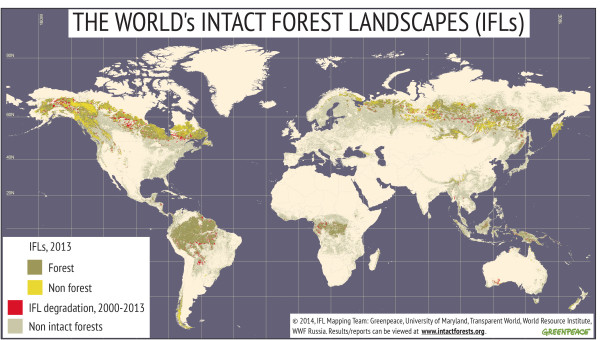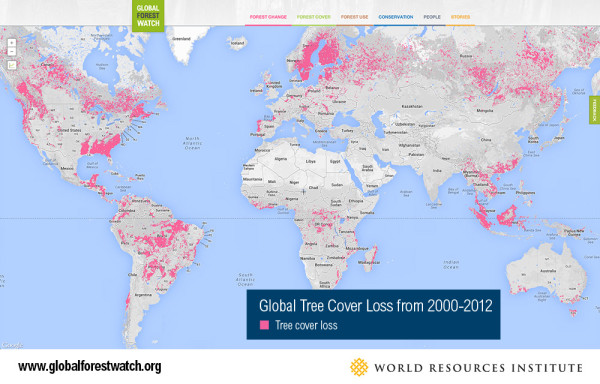80% Of Earth’s Forests Have Been Destroyed
According to the World Resources Institute (WRI), more than 80 percent of the Earth’s natural forests already have been destroyed at the rate of 20,000 hectares per day and the main report Global Forest Resources Assessment 2010 (FRA 2010) has examined the status and trends for more than 90 variables and all types of forests in 233 countries and areas, saying that the rate of deforestation shows signs of decreasing, but is still alarmingly high.
Forests cover 31 percent of total world land area and play a critical role in mitigating climate change: deforestation, degradation and poor forest management reduce carbon stocks. Climate change affects forests, especially alters the disturbance dynamics of the native forest insect pests and pathogens, increasing the effects and susceptibility to other disturbances. Furthermore, changes in ecosystems and planted forests and extreme events and disasters have had important impacts on the productive function.

Mapping team: Greenpeace’s GIS Laboratory, University of Maryland and Transparent World, World Resource Institute, WRI and WWF Russia.
The world’s total forest area is just over 4 billion hectares, but first of all we need to know that the area of forest is unevenly distributed: the five most forest rich countries are the Russian Federation, Brazil, Canada, the United States of America and China. According to most recent updated analysis conducted by the Intact Forest Landscapes (IFLs) mapping group, including Greenpeace’s GIS Laboratory, University of Maryland and Transparent World, with support from WRI and WWF Russia, in the 2013 the IFLs covered 11.81 million km2, 9.53 million km2 (81%) of which was forest and 65% of the world’s IFLs are located today in just three countries: Canada, Russia and Brazil, but only 13% of IFLs are inside protected areas.
The effects of climate change is affecting our forests by altering the frequency, intensity and the timing of fire, drought, windstorms, introduced species or landslides, and show clear signs of past interventions of humans. Fire burns million of hectares of forest worldwide and when a forest burns in the wrong place and at the wrong temperature can be devastating, causing loss of property and human life. We know that all the natural disturbances interact with human-induced effects on our environment, such air pollution for example: it is estimated that 15% of all greenhouse gas emissions are the result of deforestation. Insect pests and diseases or invasive species are causing severe damage in some countries like Canada and the western United States of America (USA) since the late 1900s.
Canada reported the highest area of insect disturbance for a single country of 17.3 million hectares. This included major outbreaks in Canada of two indigenous species in 2006: the mountain pine beetle (Dendroctonus ponderosae), which damaged 9.2 million hectares of forest, and the forest tent caterpillar (Malacosoma disstria), which affected 5 million hectares. But Cnada has other difficulites as Peter Lee of Global Forest Watch Canada, an independent Canadian NGO, has said: “In Canada’s northern Alberta’s oil sands region, more than 12.5 million hectares of forest have been crisscrossed by roads, pipelines, power transmission lines and other infrastructure. Massive increases in oil sands and shale gas developments, as well as logging and road building, are the major cause of Canada’s forest loss”. At least 120,000 km2 of Canada’s intact forest landscape has likely declined between circa 2001 and circa 2010.
While Greenpeace is campaigning for zero deforestation by 2020, challenging destructive industries to change their practices and inspiring consumer actions, we need to know that wood removals increased between 2000 and 2005, following a fall in the 1990s: in the period 2003-2007, at the global level, wood removals amount is 3.4 billion cubic meters annually (illegally removed wood is not recorded so the total is definitely higher). Another problem is that forest biomass, the decrease in total is mainly a result of the loss of forest area, and in terms of dry weight of living organisms is an important measure for analysing ecosystem productivity.
South America and Africa (3.4 million hectares annually) continue to have largest net loss of forest, as Oceania, reporting about 700.000 ha per year over the periods 2000-2010. The results of the FRA assessment are encouraging in some respects: afforestation and natural expansion in some countries and regions (tropical region) have reduced the net loss of forests, so it is happening with many emerging economies who have moved from net loss to net gain of forest area. There are many good signs and positive trends at the global level, particularly in the last ten years, but many negative trends remain at regional, subregional and national levels.
Significant progress has been made in developing forest policies, laws and national forest programmes so deforestation is decreasing in several countries but continues at high rate in others (especially Brasil and Indonesia) but pursuant to Green Peace International the major problems are:
-
Fragmented forests can suffer form die back along their edges: fragmentation may cause up to 150 million tonnes of carbon per yera to be lost to the atmosphere
-
Much of the Amazon rainforest coud become savannah within 50 years
-
Roads are the pathways to forest destruction.
We have global objective on forests: reverse the loss of forest cover thorough sustainable management, enhance forest based economic, social and environmental benefits, increase the area of protected forests worldwide, but the most important objective is to reverse the decline in official development assistance for sustainable forest management. Intact Forest Landscape (IFLs) have extremely important conservation value, providing crucial ecosystem services such as regulating water and nutrient cycles, and they are more resilent to climate change impacts.






Hi Daniel, I’m so sorry for the delay in the answer. To be clear, IDEALLY about 70% of the earth should be covered by the oceans, while 30% by forests, more or less..:). So 80% is a seriously damaged part of this 30% . Fortunately 10% of the world’s forests are now protected areas. So now is clear what I wrote. :). Thank you for your intervention. Olivia.
If 80% of forests have been removed, how is it that today 31% of the land is still covered by forests? This seems to imply that there was some deforestation happing in the ocean.